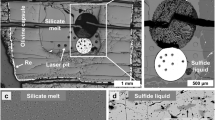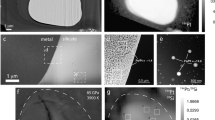Abstract
As the Earth accreted, metallic materials segregated from silicates to form the iron-rich core. The proportions of the refractory lithophile elements in the silicate part of the Earth are thought to have remained similar to that of chondrite meteorites throughout accretion1. However, although niobium (Nb) and tantalum (Ta) are both classified as refractory lithophile elements and share a similar degree of incompatibility in mineral structures2, the Nb/Ta ratio of the bulk silicate Earth is subchondritic3. To explain this paradox, it has been proposed that Nb becomes siderophile at the high pressures of core formation, and was preferentially removed from the silicate Earth4,5,6. Here we conduct metal/silicate partitioning experiments at a range of oxygen fugacities and show that Nb and Ta are both siderophile elements under reducing conditions, but become so at different oxygen fugacities, leading to fractionation. We find that pressure has a negligible influence on the Nb/Ta ratio. Applying our partitioning data to existing theoretical accretion models7,8, we reproduce the Nb/Ta ratios of the bulk silicate Earth, Mars and the differentiated asteroid 4 Vesta, and discuss the implications for Moon formation. We conclude that planetary accretion of reduced materials played an important role in the chemical evolution of Earth and, more generally, that Nb and Ta can be used to trace prevailing oxygen fugacities during the segregation of planetary cores.
This is a preview of subscription content, access via your institution
Access options
Subscribe to this journal
Receive 12 print issues and online access
$259.00 per year
only $21.58 per issue
Buy this article
- Purchase on Springer Link
- Instant access to full article PDF
Prices may be subject to local taxes which are calculated during checkout



Similar content being viewed by others
References
Kargel, J. S. & Lewis, J. S. The composition and early evolution of Earth. Icarus 105, 1–25 (1993).
Hofmann, A. W. Chemical differentiation on the Earth: The relationship between mantle, continental crust, and oceanic crust. Earth Planet. Sci. Lett. 90, 297–314 (1988).
Münker, C. et al. Evolution of planetary cores and the Earth–Moon system from Nb/Ta systematics. Science 301, 84–87 (2003).
Wade, J. & Wood, B. J. The Earth’s “missing” niobium may be in the core. Nature 409, 75–78 (2001).
Corgne, A., Keshav, S., Wood, B., McDonough, W. & Fei, Y. Metal–silicate partitioning and constraints on core composition and oxygen fugacity during Earth accretion. Geochim. Cosmochim. Acta 72, 574–589 (2008).
Mann, U., Frost, D. J. & Rubie, D. C. Evidence for high-pressure core-mantle differentiation from the metal–silicate partitioning of lithophile and weakly-siderophile elements. Geochim. Cosmochim. Acta 73, 7360–7386 (2009).
Wade, J. & Wood, B. J. Core formation and the oxidation state of the Earth. Earth Planet. Sci. Lett. 236, 78–95 (2005).
Rubie, D. C. et al. Heterogeneous accretion, composition and core–mantle differentiation of the Earth. Earth Planet. Sci. Lett. 301, 31–42 (2011).
Morbidelli, A., Lunine, J. I., O’Brien, D. P., Raymond, S. N. & Walsh, K. J. Building terrestrial planets. Annu. Rev. Earth Planet. Sci. 40, 251–275 (2012).
Sun, S. S. & McDonough, W. F. Chemical and isotopic systematics of oceanic basalts: Implications for mantle composition and processes. Geol. Soc. Spec. Publ. 42, 313–345 (1989).
Burnham, A. D., Berry, A. J., Wood, B. J. & Cibin, G. The oxidation states of niobium and tantalum in mantle melts. Chem. Geol. 330–331, 228–232 (2012).
Rudnick, R., Barth, M., Horn, I. & McDonough, W. Rutile-bearing refractory eclogites: Missing link between continents and depleted mantle. Science 287, 278–281 (2000).
Nebel, O., van Westrenen, W., Vroon, P. Z., Wille, M. & Raith, M. M. Deep mantle storage of the Earth’s missing niobium in late-stage residual melts from a magma ocean. Geochim. Cosmochim. Acta 74, 4392–4404 (2010).
Righter, K., Drake, J. M. & Scott, E. in Meteorites and the Early Solar System II (eds Lauretta, D. S. & McSween, H. Y. Jr) 803–828 (Univ. Arizona Press, 2006).
Brett, R. & Sato, M. Intrinsic oxygen fugacity on seven chondrites, a pallasite, and a tektite and the redox state of meteorite parent bodies. Geochim. Cosmochim. Acta 48, 111–120 (1984).
McDonough, W. F. & Sun, S. S. The composition of the Earth. Chem. Geol. 120, 223–253 (1995).
Bouhifd, M. A., Andrault, D., Bolfan-Casanova, N., Hammouda, T. & Devidal, J. L. Metal–silicate partitioning of Pb and U: Effects of metal composition and oxygen fugacity. Geochim. Cosmochim. Acta 114, 13–28 (2013).
O’Neill, H. & Palme, H. Collisional erosion and the non-chondritic composition of the Earth. Phil. Trans. R. Soc. A 366, 4205–4238 (2008).
Carlson, R. W. & Boyet, M. Composition of the Earth’s interior: The importance of early events. Phil. Trans. R. Soc. A 366, 4077–4103 (2008).
Rubie, D. C., Melosh, H. J., Reid, J. E., Liebske, C. & Righter, K. Mechanisms of metal–silicate equilibration in the terrestrial magma ocean. Earth Planet. Sci. Lett. 205, 239–255 (2003).
Wadhwa, M. Redox conditions on small bodies, the Moon and Mars. Rev. Mineral. Geochem. 68, 493–510 (2008).
Righter, K. & Drake, M. J. A magma ocean on Vesta: Core formation and petrogenesis of eucrites and diogenites. Meteorit. Planet. Sci. 32, 929–944 (1997).
Canup, R. M. & Asphaug, E. Origin of the Moon in a giant impact near the end of the Earth’s formation. Nature 412, 708–712 (2001).
Wieczorek, M. A. The constitution and structure of the lunar interior. Rev. Mineral. Geochem. 60, 221–364 (2006).
Cuk, M. & Stewart, S. T. Making the Moon from a fast-spinning Earth: A giant impact followed by resonant despinning. Science 338, 1047–1052 (2012).
Canup, R. M. Forming the Moon with an Earth-like composition via a giant impact. Science 338, 1052–1055 (2012).
Reufer, A., Meier, M. M. M., Benz, W. & Wieler, R. A hit-and-run giant impact scenario. Icarus 221, 296–299 (2012).
Lesher, C. H. Decoupling of chemical and isotopic exchange during magma mixing. Nature 344, 235–237 (1990).
Corgne, A., Liebske, C., Wood, B. J., Rubie, D. C. & Frost, D. J. Silicate perovskite-melt partitioning of trace elements and geochemical signature of a deep perovskitic reservoir. Geochim. Cosmochim. Acta 69, 485–496 (2005).
Siebert, J., Corgne, A. & Ryerson, F. J. Systematics of metal–silicate partitioning for many siderophile elements applied to Earth’s core formation. Geochim. Cosmochim. Acta 75, 1451–1489 (2011).
Acknowledgements
The authors thank O. Laurent for discussion. This research received funding from the European Research Council under the European Community’s Seventh Framework Program (FP7/2007-2013 Grant Agreement 209035) and from the French PNP program (INSU-CNRS). The multi-anvil apparatus of Laboratoire Magmas et Volcans is financially supported by the Centre National de la Recherche Scientifique (Instrument National de l’INSU). This is Laboratory of Excellence ClerVolc contribution no. 101.
Author information
Authors and Affiliations
Contributions
All authors contributed equally to this work. C.C. conducted the experiments and prepared the samples. C.C. and J-L.D. acquired and reduced the data. Modelling and manuscript preparation were carried out by C.C., T.H., M.B. and M.A.B. All authors discussed the results and implications and commented on the manuscript at all stages.
Corresponding author
Ethics declarations
Competing interests
The authors declare no competing financial interests.
Supplementary information
Rights and permissions
About this article
Cite this article
Cartier, C., Hammouda, T., Boyet, M. et al. Redox control of the fractionation of niobium and tantalum during planetary accretion and core formation. Nature Geosci 7, 573–576 (2014). https://doi.org/10.1038/ngeo2195
Received:
Accepted:
Published:
Issue Date:
DOI: https://doi.org/10.1038/ngeo2195
This article is cited by
-
Sub-arc mantle enrichment in the Sunda rear-arc inferred from HFSE systematics in high-K lavas from Java
Contributions to Mineralogy and Petrology (2022)
-
The Diverse Planetary Ingassing/Outgassing Paths Produced over Billions of Years of Magmatic Activity
Space Science Reviews (2021)
-
Tracing anthropogenic sources of Tantalum and Niobium in Bothnian Bay sediments, Sweden
Journal of Soils and Sediments (2021)
-
Silicate Earth’s missing niobium may have been sequestered into asteroidal cores
Nature Geoscience (2017)
-
The lunar core can be a major reservoir for volatile elements S, Se, Te and Sb
Scientific Reports (2017)



